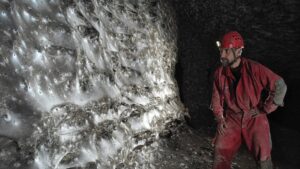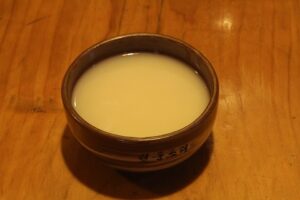The yellow-eyed penguins, scientifically known as Megadyptes antipodes and colloquially referred to as Hoiho, is one of the rarest penguin species in the world. Native to New Zealand, these unique birds are distinguished by their striking pale yellow eyes and distinctive yellow band that encircles their head. Hoiho are medium-sized penguins, typically standing about 65 to 75 centimeters tall. They have a robust body, with a bluish-grey plumage on their back and a lighter, cream-colored belly. Unlike many other penguins, yellow-eyed penguins prefer to nest in dense coastal forests and bush areas, which provide protection from predators. Their population is concentrated along the eastern and southern coasts of New Zealand’s South Island, as well as on some offshore islands.
 Pin
Pin Image from Wikimedia
Unfortunately, the yellow-eyed penguin is designated as endangered, with current estimates suggesting a population of fewer than 5,000 individuals. This alarming decline is attributed to various factors, making it crucial to address their endangered status. Discussing the plight of Hoiho is vital for several reasons. Firstly, understanding the factors contributing to their endangerment allows conservationists, policymakers, and the public to implement effective strategies to protect their habitats and mitigate threats. Awareness of these issues enables individuals to actively participate in conservation efforts and promote better policies that safeguard not only penguins but also the entire ecosystem in which they thrive.
Highlighting the endangered status of yellow-eyed penguins raises awareness about broader environmental challenges, such as habitat destruction, climate change, and the impact of invasive species. By focusing on Hoiho, we shed light on the interconnectedness of species and ecosystems, illustrating how the decline of one species can signify larger ecological problems. This awareness can galvanize communities and encourage them to take collective action.
Preserving yellow-eyed penguins serves as an opportunity to foster appreciation for New Zealand’s unique biodiversity. As keystone species, their presence is indicative of healthy marine and coastal environments. By discussing their endangered status, we not only advocate for their survival but also foster a deeper understanding of the natural world and its fragility, inspiring future generations to value and protect their rich natural heritage.
Table of Contents
Description of Yellow-Eyed Penguins
 Pin
Pin Image from Wikimedia
Yellow-eyed penguins (Megadyptes antipodes) are one of the world’s rarest penguin species, native to New Zealand. They are distinguished by their striking yellow eyes and a unique band of yellow feathers that extends from their eyes around the back of their heads. Adult yellow-eyed penguins have a stout, robust body covered in slate-gray plumage on the back and white underparts. They stand approximately 65 to 75 cm tall and weigh between 2.5 to 5.5 kg. Their beaks are relatively long and have a pinkish hue, facilitating their diet of fish and crustaceans.
Habitat and Geographic Distribution
 Pin
Pin Image from Wikipedia
Yellow-eyed penguins primarily inhabit the southern coasts of New Zealand, particularly on the Stewart Island and the Otago Peninsula. They prefer dense coastal forests or scrubland that provide cover from predators and harsh weather. These penguins often nest in hidden locations among dense vegetation, using tree roots and shrubs as shelters. Their breeding season occurs from August to December, where they establish nests either in grass burrows or among stones.
Unique Characteristics and Behavior
Yellow-eyed penguins possess several unique behaviors that set them apart from other penguin species. Unlike their more sociable relatives, they are relatively solitary and prefer minimal interaction, especially during the breeding season. They are known for their strong homing instincts, returning to the same nesting site year after year. Their diet mainly consists of fish, squid, and crustaceans, which they catch while diving, often reaching depths of up to 20 meters.
One notable behavior is their vocalization; they produce a range of sounds, including guttural calls, which are used for communication between mates and during nesting. They also display a unique courtship ritual that involves synchronized movements and mutual preening. Yellow-eyed penguins have adapted to the temperate climate of New Zealand, but they face threats such as habitat loss, predation by introduced species, and climate change, which has led to a decline in their population. Conservation efforts are ongoing to protect and help restore their habitats and numbers.
Effects of Coastal Development
Coastal development poses a significant threat to yellow-eyed penguins and their habitats. Urbanization, tourism infrastructure, and agricultural expansion along New Zealand’s coastal regions have led to several detrimental impacts:
- Nesting Sites Destruction: Coastal construction often involves land clearing, which diminishes the natural vegetation that provides essential cover for nests. Yellow-eyed penguins prefer secluded nesting locations, and many of these are being converted into buildings or open areas, leaving penguins exposed to predators and harsh weather.
- Human Disturbance: Increased human activity along coastlines, including recreational activities and tourism, can lead to disturbances in penguin breeding and foraging behaviors. Noise pollution and the presence of people can scare penguins away from nesting sites, disrupting breeding success and leading to abandonment of nests.
- Predation: Development often brings non-native species such as cats and dogs into penguin habitats. These animals are significant predators of chicks and adults alike, increasing mortality rates. The fragmentation of habitats due to development can also isolate penguin populations, making it harder for them to find suitable nesting sites away from predators.
- Pollution: Coastal development contributes to pollution, including plastic waste and chemical runoff from agribusiness. This pollution can affect the marine ecosystems that penguins rely on for food, leading to declines in fish stocks and negatively impacting their foraging success.
Climate Change on Habitats
Climate change poses an existential threat to yellow-eyed penguins, influencing their habitats in several ways:
- Sea-Level Rise: As sea levels rise due to melting ice caps and thermal expansion, low-lying coastal areas—critical nesting sites for yellow-eyed penguins—are at risk of inundation. Flooding can destroy nests and reduce available habitat, pushing penguins to search for new, potentially less suitable areas.
- Temperature Increases: Changes in temperature can disrupt penguin breeding cycles. Warmer temperatures may lead to earlier breeding seasons, which could misalign the timing of chick hatching with peak food availability, resulting in below-average chick survival rates.
- Ocean Acidification: Increased carbon dioxide levels are leading to ocean acidification, which negatively affects marine biodiversity. As key prey species for yellow-eyed penguins, such as fish and squid, suffer from these changes, the penguins’ ability to find sufficient food becomes compromised.
- Habitat Alteration: Climate changes can lead to shifts in vegetation and habitat types along coastlines. These alterations may affect not only the nesting preferences but also the availability of cover from predators, further stressing the penguin populations.
Both coastal development and climate change significantly threaten the natural habitats of yellow-eyed penguins. These factors not only compromise their nesting sites but also disrupt their feeding patterns, ultimately leading to a decline in population numbers and biodiversity. Conservation efforts must prioritize habitat protection and restoration to combat these ongoing challenges.
Predation
Invasive species pose a significant threat to native wildlife, particularly in isolated ecosystems like those inhabited by penguins. Dogs, cats, and rats are notable examples of such invasive species, often introduced through human activity. Domestic dogs, when feral or allowed to roam freely, can hunt and injure adult penguins, disrupting breeding patterns and causing stress within colonies.
Cats are highly efficient predators, especially on smaller penguin species and their eggs. They can lead to significant declines in populations by preying on chicks and adult birds. The presence of rats further exacerbates this issue; these rodents often invade nesting sites, consuming eggs and chicks, significantly impacting reproductive success. The competition for resources also increases, as these invasive species exploit the same food sources, leading to starvation among native species like penguins.
The ecological balance is disrupted, as natural checks on feral animal populations are often absent in newly invaded areas. This can lead to overpopulation of these invasive species, resulting in further pressure on vulnerable penguin colonies. The loss of habitat due to human encroachment compounds these challenges, creating a precarious situation for native wildlife.
Natural Predators and Their Effects on Penguin Populations
While invasive species are a pressing concern, natural predators also play a crucial role in shaping penguin populations. Species such as leopard seals, skuas, and even certain types of gulls target penguins, especially during breeding seasons when penguins congregate in large colonies.
Leopard seals are apex predators in the marine environment and can pose a direct threat to adult penguins. Their hunting tactics often involve ambushing penguins as they enter or exit the water. Though the interaction promotes natural selection, ensuring only the fittest survive, it can also lead to declines in local penguin populations if seal numbers are high.
Skuas, known for scavenging, primarily prey on penguin eggs and chicks. When skua populations increase, they can surpass what penguin colonies can sustain, leading to reduced reproductive success. The impact of skuas can be particularly pronounced in years with low food availability, leading to greater predation pressure on penguin nests.
Invasive species and natural predators have significant effects on penguin populations. The introduction of invasive species endangers penguins through direct predation and competition, while natural predators can influence their survival through ecological balance, highlighting the complexity of predator-prey relationships in these ecosystems.
Common Diseases Affecting Yellow-Eyed Penguins
Yellow-eyed penguins (Megadyptes antipodes) are endemic to New Zealand and are particularly vulnerable to various diseases. Some of the most common diseases affecting these penguins include:
- Avian Malaria: This mosquito-borne disease is caused by the Plasmodium parasite, leading to anemia, lethargy, and increased mortality, especially in juvenile birds.
- Bacterial Infections: Various bacteria, including E.coli and Achromobacter, can cause infections in yellow-eyed penguins, often leading to septicemia. These infections can arise from environmental stressors or poor nutrition.
- Fungal Infections: Fungal diseases, such as aspergillosis, can occur, particularly in weakened individuals, leading to respiratory issues and often resulting in death.
- Coccidiosis: This parasitic infection affects the intestinal tract, leading to diarrhea, dehydration, and malnutrition, severely impacting young and stressed birds.
- Pneumonia: Often a secondary condition linked to other diseases or environmental stressors, pneumonia in yellow-eyed penguins can result from poor habitat quality or overcrowding.
The Role of Pathogens in Population Decline
Pathogens play a significant role in the decline of yellow-eyed penguin populations. Several factors contribute to this issue:
- Immunosuppression: Environmental stressors, such as habitat destruction and climate change, can lead to reduced immunity in these penguins, making them more susceptible to diseases.
- Increased Disease Transmission: High population densities, exacerbated by habitat loss and reduced breeding sites, can lead to increased contact among individuals, facilitating the spread of pathogens.
- Impact of Predators: Introduced predators, such as cats and rats, not only threaten penguin eggs and chicks but also stress adult penguins, which can further weaken their immune systems and heighten disease susceptibility.
- Climate Change: Changes in climate can alter the distribution of disease vectors, such as mosquitoes, potentially exposing yellow-eyed penguins to diseases like avian malaria in new areas.
- Conservation Challenges: Efforts to conserve yellow-eyed penguins must consider the health impacts of pathogens. Interventions, such as habitat restoration and predator control, can alleviate stress and reduce disease incidence.
The health of yellow-eyed penguins is profoundly affected by various diseases, primarily driven by environmental stresses and pathogens. Addressing these issues through effective conservation strategies is crucial for the survival of this vulnerable species.
Human Intervention - Fishing Practices and Overfishing
Human intervention in marine ecosystems is profoundly illustrated through fishing practices. Commercial fishing techniques have evolved significantly, allowing for large-scale extraction of fish from oceans and rivers. Methods like trawling, longlining, and gillnetting can deplete fish stocks dramatically. Overfishing occurs when fish are harvested at rates faster than they can reproduce, leading to population declines, disrupting food chains, and threatening the livelihoods of communities reliant on fishing.
Bycatch, the unintentional capture of non-target species, further exacerbates the issue, killing millions of marine animals, including turtles, dolphins, and juvenile fish critical to population recovery. Overfishing disrupts marine biodiversity, leading to the decline of predator species and altering ecosystem dynamics. Moreover, illegal, unreported, and unregulated (IUU) fishing practices undermine sustainable management efforts, making it challenging to implement effective conservation strategies.
The socioeconomic impact of overfishing is equally concerning. Coastal communities that depend on fishing for food security and employment face economic difficulties as fish populations dwindle. This can lead to increased poverty and food shortages, forcing communities to seek alternative livelihoods that may further stress environmental resources.
Tourism Impacts and Environmental Disturbances
Tourism significantly affects ecosystems, particularly in sensitive areas such as coral reefs, wetlands, and coastal regions. Increased visitor numbers can lead to habitat degradation, pollution, and resource depletion. Coastal tourism often involves the construction of hotels, roads, and other infrastructure, resulting in habitat loss and fragmentation.
In areas like coral reefs, snorkeling and diving activities pose serious threats by causing physical damage to delicate structures, while the anchorages from boats can break coral. Additionally, the introduction of pollutants from waste and litter contribute to water quality deterioration, affecting marine life.
Wildlife tourism can also lead to disturbances in animal behavior. Habituation to human presence alters natural patterns, impacting breeding, feeding, and migration. Practices such as feeding wildlife to attract tourists can disrupt food webs.
Tourism brings a surge in consumptive activities, leading to the over-exploitation of natural resources. The demand for souvenirs, marine products, and land for resorts contributes to a cycle of environmental degradation.
Human intervention through fishing practices and tourism poses significant threats to marine and terrestrial ecosystems, highlighting the urgent need for sustainable practices and comprehensive management strategies to mitigate these impacts.
Conservation Efforts for Hoiho
- Existing Conservation Programs: Hoiho, or the yellow-eyed penguin, is endemic to New Zealand and faces numerous threats, including habitat loss, introduced predators, and environmental changes. Current conservation efforts focus on habitat restoration, predator control, and breeding program initiatives. Programs like the Yellow-eyed Penguin Trust work to protect the species through habitat rehabilitation, which involves restoring coastal ecosystems and removing invasive plant species. The Penguin Rehabilitation Centre also plays a crucial role in the recovery of injured or sick penguins. Additionally, monitoring populations through field studies helps assess the effectiveness of these conservation measures.
- Role of Local Organizations in Protecting Hoiho: Local organizations are vital in protecting Hoiho populations. The Yellow-eyed Penguin Trust collaborates with stakeholders, coordinating efforts that involve community volunteers in habitat restoration and penguin monitoring. They target specific areas, applying targeted predator control measures, particularly against ferrets, stoats, and cats, which pose significant threats to penguin nests and chicks. Moreover, organizations like Forest & Bird advocate for stronger policies and support legislation that helps mitigate habitat destruction. These local initiatives foster a community-centered approach to conservation, emphasizing the need for collective action.
- Community Engagement and Awareness Initiatives: Community engagement is crucial in conservation efforts for Hoiho. Education and outreach programs aim to raise awareness about the penguin’s plight and the importance of biodiversity. Schools and community groups participate in citizen science projects, such as surveying penguin populations and nesting sites, encouraging local stewardship. Workshops and informational campaigns highlight sustainable practices and the impact of everyday actions on wildlife survival. Events like the Hoiho Day promote direct involvement by allowing the community to participate in habitat clean-ups and restoration activities. Engaging local cultures and narratives fosters a deeper connection to the ecosystem, ensuring the community feels invested in the penguin’s future.
Conservation efforts for the Hoiho hinge on a combination of structured programs, active local organizations, and robust community involvement, working together to ensure the survival of this iconic species while promoting ecological balance in its habitat.































